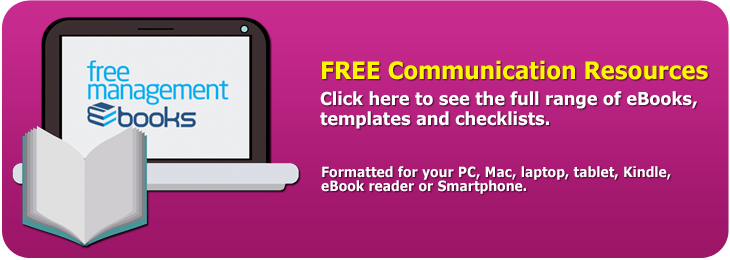Communication Skills - Management Presentation Planning Guidelines
As a manager, there are several types of presentation that you will need to make as part of your normal responsibilities. These include presentations to your own team, to senior management, to internal groups outside of your reporting structure, and to external groups like suppliers, customers, and partners.
In almost all of these cases, individual audience members will be preoccupied with their day-to-day work and will 'zone out' of a presentation if they think it does not affect them directly. People already feel that there are too many presentations and that most of them go on far too long.
There are very few circumstances in which you will find an audience to be enthusiastic about what you are about to say. When you get up to speak the most common thought in people's minds is usually 'This had better be short, to the point, and worth listening to as I've got a stack of things to do!'
This means that any presentation you give should engage the audience as quickly as possible and should keep them focused on your message all of the time you are speaking. To achieve this, you need to develop an approach to preparing presentations that gives you a clear 'key message' and supporting structure, so that even when you don't have much time to prepare you can still capture and hold the audience's attention. You can use a four-stage process to achieve this.
Identify Your Aim
The first stage of the planning process is to decide on the precise aim of your presentation. This focuses your mind on what it is that you are trying to achieve.
Know Your Audience
It is essential to know your audience and to make sure that your presentation takes account of their existing knowledge. Audience profiling can help you with this, but you also need to use common sense and experience.
Audience size has implications for the level of complexity of your presentation because, generally speaking, the bigger the audience, the less the individual members have in common, and the simpler the content needs to be. It will also have a bearing on the kind of visual aids that will be appropriate and whether or not you should rely on notes or a full script.
Define Your Key Message Statement
You can only expect your audience to remember one key message or theme. This should be summarized in a key message statement, which forms the title of your presentation.
The best approach is to set yourself a strict time limit to come up with some options for your key message statement and then choose the best one because you can always amend it later if you need to. The key message statement is important because it makes it easier for you to decide what to include and what to omit from your presentation.
Outline Scope
A presentation needs three to five key points to support the key message statement. The most efficient way to decide on these is to use a mind map to get all of the possible content documented, and then to create your key points based on your aim, audience, and the key message statement.
Once you have identified:
1) the aim of your presentation;
2) the key message statement; and
3) three to five key points that support the key message statement
you are ready for the next stage, which is to take this information and to create a presentation that is well structured, clear, and concise. This process is described in detail in the eBook 'Preparing a Presentation,' which you can download free from this website.
You may also be interested in:
Planning a Management Presentation | Everyday Management Presentations | Advantages and Disadvantages of Presentations | Four-Stage Presentation Planning Process | Audience Profiling | Presentation Environment | Define Your Key Message Statement | Outline the Scope of Your Presentation.


